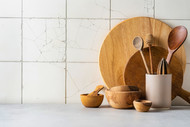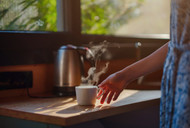
The Best Oils For Wood Cutting Boards
Nov 4th 2020
Wooden cutting boards are a great addition to your kitchen, but require proper care. Wood is porous, which means that it absorbs water and other liquids you spill on it. A buildup of liquid in a wood cutting board has a number of consequences including warping, separating, or even mold growth.
We've been making butcher block cutting boards for a long time, so we know a few tried and true techniques for taking care of them. One of the safest ways to treat your cutting board is with a natural oil that can repel liquids.
Here's our list of the best oils for your wood cutting board.
Mineral Oil
Mineral oil repels water and can prevent absorption leading to potential warping. The type of “mineral oil” used for cutting boards is “food grade mineral oil”, it’s non-toxic and is a vital ingredient that can help maintain the longevity of your cutting board.
How to Use Mineral Oil on Cutting Boards:
- Apply a generous amount of mineral oil to your cutting board with a non-static cloth such as a microfiber cloth. Avoid using paper towels that can leave residue behind.
- Allow the oil to coat the cutting board for at least 2 hours before wiping away any excess.
- Repeat the oiling process monthly. Bi-weekly is recommended if you use the cutting board daily.
Fractionated Coconut Oil
Fractionated coconut oil, the oil that is left after fat has been removed from regular coconut oil, has antibacterial features that are perfect to treat cutting boards.

How to Use Coconut Oil on Cutting Boards:
- Apply a teaspoon of the coconut oil on the surface of the cutting board and rub it in with your hand in line with the grain. Repeat three or four times.
- It’s recommended that you let the cutting board dry for six hours after applying the coconut oil before using it.
- Wipe off any excess oil to prevent unwanted buildup or stickiness on your cutting board.
- The application of coconut oil should be used monthly or whenever your cutting board looks dry.
Are you ready to shop for your next cutting board?
Shop Our Wood Cutting Board Selection
Beeswax
While not an oil, beeswax is natural, food safe, and great for protecting wood cutting boards. A beeswax treatment helps safeguard wood, and also enhances a cutting board’s visual charm.
How to Use Beeswax on Cutting Boards:
- To treat your cutting board with beeswax, warm the wax until it is soft and easy to apply. We've found submerging the sealed container of beeswax into warm water does a great job of softening it.
- When applying the beeswax, be sure to use consistent pressure to the cutting board and apply the wax in the same direction as the wood grain.
- Once the beeswax coats the cutting board, clear off the excess wax with a clean cloth and wait at least 24 hours before using the cutting board. Repeat monthly or as needed with regular cutting board use.
Combining Beeswax With Mineral Oil
One of our favorite ways to protect, replenish, and shine a cutting board is to use mineral oil and beeswax.
How to Use Beeswax and Mineral Oil on Cutting Boards:
- Apply the mineral oil first per our earlier instructions, let the oil settle, and then coat with a layer of beeswax per the directions above.
- Once the applications are settled into the cutting board you will see an end result of a deep shine with two layers of protection.
- The application of beeswax and mineral oil can be applied monthly unless the wood fibers look dried out.
What Not to Use on Your Cutting Board
The oils above are great products that can be used to care for your cutting boards, but there are products that should be avoided if you want to keep your boards in good condition.
- Cooking Oils: Never use any type of cooking oil, such as olive oil, vegetable oil, or regular coconut oil, on your board. These oils are chemically different from those listed above. Cooking oils will turn rancid when exposed to air and ruin your cutting board.
- Excessive Water: Submerging your wood cutting boards in water can cause warping and cracking, especially if they are left soaking for a lengthy period. This includes running a wood cutting board through the dishwasher.
- Common Household Cleaners: Avoid using bleach, and all-purpose cleaners that contain harsh chemicals so that you avoid damaging the natural elements of your wood cutting boards.
Start with a High-Quality Cutting Board
For the longest lasting cutting board, be sure to invest in an option made from quality materials. At The Hardwood Lumber Company, we manufacture custom wood cutting boards made with quality hardwoods and finished with food safe, lasting options.
Choosing one of our cutting boards helps ensure you get the most from your investment.





